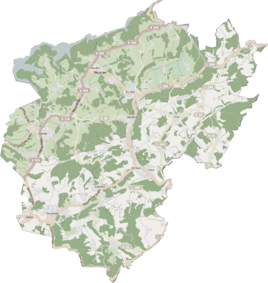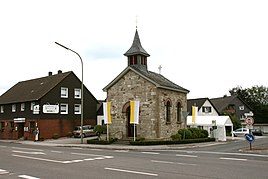Pastures (Kürten)
|
Pastures
Kurten municipality
Coordinates: 51 ° 3 ′ 50 ″ N , 7 ° 14 ′ 25 ″ E
|
||
|---|---|---|
| Postal code : | 51515 | |
|
Location of pastures in Kürten |
||
|
Weiden - View of the St. Anna Chapel
|
||
Weiden is a residential area in the municipality of Kürten in the Rheinisch-Bergisches Kreis . It has around 1200 inhabitants.
Location and description
The place is on the federal highway 506 between Eisenkaul and Hutsherweg .
history
Weiden bei Richerzhagen was first mentioned in 1340 as v. der Weyden mentioned in a document. The place name is as easy to see the tree family of pastures back. The chapel in Weiden was mentioned in a document in 1507.
The place was on the Heerweg Köln – Wipperfürth – Soest , an important medieval old long-distance road from Cologne via Wipperfürth to Soest . The route of the old Höhenstraße is still used today from the federal highway 506 , apart from small deviations .
The Topographia Ducatus Montani by Erich Philipp Ploennies from 1715, Blatt Amt Steinbach , shows that the place already existed in 1715 as a place with several courtyards and was called Wieden . Carl Friedrich von Wiebeking names the court on his charter of the Duchy of Berg in 1789 as Wieden . It shows that Weiden was part of the senior honors in the parish of Kürten in the district court of Kürten at that time .
Under the French administration between 1806 and 1813 the Steinbach office was dissolved and Weiden was politically assigned to the Mairie Kürten in the canton of Wipperfürth in the Elberfeld arrondissement . In 1816 the Prussians converted the Mairie to the mayor's office in Kürten in the Wipperfürth district . At that time, Weiden belonged to the municipality of Kürten.
The place is recorded on the topographical survey of the Rhineland from 1824 and on the Prussian first survey of 1840 as pastures . From the Prussian new admission in 1892, it is regularly recorded as willow on measuring table sheets .
In 1822, 56 people lived in the place, which was categorized as a courtyard and called pastures . In 1830 the place had 66 inhabitants and was called Weyden . According to the survey of the government district of Cologne, categorized as a hamlet with a chapel in 1845 , the town had nine houses at that time. At that time, 60 people lived in the place called Weiden, all of them of Catholic faith. The municipality and estate district statistics of the Rhine Province lists Weiden in 1871 with twelve residential buildings and 63 inhabitants. In the municipality lexicon for the Rhineland province of 1888, eleven houses with 60 inhabitants are given. In 1895 the place had ten houses and 52 inhabitants. In 1905 the place had ten houses and 46 inhabitants and belonged denominationally to the Catholic parish of Kürten.
In 1927 the mayor's office in Kürten was transferred to the office of Kürten. In the Weimar Republic in 1929 the offices of Kürten were merged with the municipalities of Kürten and Bechen and Olpe with the municipalities of Olpe and Wipperfeld to form the office of Kürten. The Wipperfürth district became part of the Rheinisch-Bergisch district on October 1, 1932, with its seat in Bergisch Gladbach .
In 1975 the current municipality of Kürten was established on the basis of the Cologne Act , to which, in addition to the offices of Kürten, Bechen and Olpe, a sub-area of the city of Bensberg with Dürscheid and the surrounding areas was added.
Attractions
The St. Anna Chapel and the former village smithy are worth seeing . The chapel was consecrated in 1507.
In Meißwinkel, 100 m away from Weiden, there is a riding stables that also offer carriage rides in the area.
traffic
Weiden can be reached quickly via the federal highway 506 (about 30 minutes from Bergisch Gladbach), as well as the Wupper-Sieg bus line , which has three stops in town.
See also
Web links
Individual evidence
- ^ A b Heinrich Dittmaier : Settlement names and settlement history of the Bergisches Land . In: Journal of the Bergisches Geschichtsverein . tape 74 , parallel edition as a publication by the Institute for Historical Regional Studies of the Rhineland at the University of Bonn. Schmidt, Neustadt ad Aisch 1956.
- ↑ a b Our Churches - Anna Chapel. Retrieved May 9, 2017 .
- ↑ Herbert Nicke : Forgotten ways: the historical network of long-distance routes between the Rhine, Weser, Hellweg and Westerwald, its protective systems and junctions . In: Land and history between Berg, Wildenburg and South Westphalia . tape 9 . Galunder, Wiehl 2001, ISBN 3-931251-80-2 , pp. 85 f .
- ^ Wilhelm Fabricius : Explanations for the Historical Atlas of the Rhine Province. Second volume: The map from 1789. Division and development of the territories from 1600 to 1794. Bonn 1898.
- ↑ JC Dänzer: Décret impérial sur la circonscription territoriale du grand-duché de Berg… Imperial decree on the division of the Grand Duchy of Berg . 1808, urn : nbn: de: hbz: 061: 1-84858 .
- ↑ a b History of the municipality of Kürten
- ↑ Alexander A. Mützell: New topographical-statistical-geographical dictionary of the Prussian state . tape 3 . Karl August Künnel, Halle 1822.
- ↑ Friedrich von Restorff : Topographical-statistical description of the Royal Prussian Rhine Province , Nicolai, Berlin and Stettin 1830
- ↑ Overview of the components and list of all the localities and individually named properties of the government district of Cologne: by districts, mayor's offices and parishes, with information on the number of people and the residential buildings, as well as the Confessions, Jurisdictions, Military and former state conditions. / ed. from the Royal Government of Cologne [Cologne], [1845]
- ↑ Royal Statistical Bureau Prussia (ed.): The communities and manor districts of the Prussian state and their population . The Rhine Province, No. XI . Berlin 1874.
- ↑ Königliches Statistisches Bureau (Prussia) (Ed.): Community encyclopedia for the Rhineland Province, based on the materials of the census of December 1, 1885 and other official sources, (Community encyclopedia for the Kingdom of Prussia, Volume XII), Berlin 1888.
- ↑ Königliches Statistisches Bureau (Prussia) (Ed.): Community encyclopedia for the Rhineland Province, based on the materials of the census of December 1, 1895 and other official sources, (Community encyclopedia for the Kingdom of Prussia, Volume XII), Berlin 1897.
- ↑ Königliches Statistisches Bureau (Prussia) (Ed.): Community encyclopedia for the Rhineland Province, based on the materials of the census of December 1, 1905 and other official sources, (Community encyclopedia for the Kingdom of Prussia, Volume XII), Berlin 1909.
- ^ GV. NRW. 1974 p. 1072

